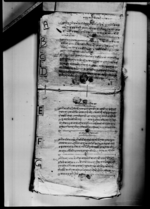A copy of a lālamohara from King Gīrvāṇayuddha directing Sarvajita Nāu to provide plants for Dasaĩ rituals (VS 1863)
ID: K_0030_0021F
Edited and
translated by Astrid Zotter
Created: 2019-02-25;
Last modified: 2023-07-06
For the metadata of the document, click here
The accompanying edition, translation/synopsis and/or commentary are available under the terms of the Creative Commons Attribution-ShareAlike 4.0 International License
Abstract
This copy of a lālamohara from the king, who according to the date must have been Gīrvāṇayuddha, allocates land to Sarvajīta Nāu and orders him to provide his services in supplying plants needed for rituals on the occasion of the two Dasaĩs at Gorkha.Diplomatic edition
[1r]
1१७८12आगेसर्वजीतनाउके•गोर्षाकोकीडीषोलाकोजैराम्यातुल्याकुभा
3लवस्याकाजगा•२दसैमाचाहीन्यासर्वऔषडीफुललाउन्यानीमी
4त्त•कुलचन्द्रसाहले•षाय़ावमोजिं•राषिवक्स्यौ•आफ्नाषातीर
5ज्मासीत्त•२दसैकोटहलमारुजुरही•भोग्येगरईतीसम्वट्मीतीस
6डर— — — — — — —१ [Unknown seal]
Translation
[1r]
1781
Āge: To Sarvajīta Nāu
We allocate [to you] a piece of land at Gorkhā's Kiḍī Kholā—[whereon at present] Jairāmyā [and] Tulyā Kubhāla3 reside—for the purpose of bringing the sarvauṣadhi [and] flowers4 needed during the 2 Dasaĩs,5 according to what has been enjoyed by Kulacandra Sāha. Be present for the services [entrusted to you] during the 2 Dasaĩs, conscious of your duties, and enjoy [the attendant fruits].
The date is confirmed.
Commentary
The scribe uses -ḍa instead of -da and -dha in all instances, except for in the word dasai. This ideosyncratic rendering of retroflex for dental consonants also applies to the spelling samvaṭ.
Though the document does not explictly say so, it in all likelihood pertains to material provisions for the Dasaĩ rituals performed at Gorkha Palace. The document is very terse, but it seems likely that the land allocated to the addressee was meant to be a place of residence for him, thereby implying that the other persons mentioned, Jairāmyā and Tulyā Kubhāla, had not only been the previous landholders but had also been in charge of providing the plants.
It would facilitate the comprehension of the document to learn more about what is meant by the phrase "according to what has been enjoyed by Kulacandra Sāha". Kulacandra Śāha was the son of King Pṛthvīnārāyaṇa's brother Dalamardana Śāha. He is known to have held a seven-year ijārā contract for the cultivation of land in Rautahat up to VS 1862 (1805 CE, Regmi 1988), the year preceding the issue of the present document. According to B. Acharya, in the same year, in March 1805, Bhīmasena Thāpā, "with the aim of taking over his house at Indrachok" (Acharya 1972: 162) blinded Kulacandra by pouring poison into his eyes.6 The boy, at that time 10 years old, was imprisoned. Did this deprivation of liberty and property also include rights Kulacandra held over land in Gorkha?

